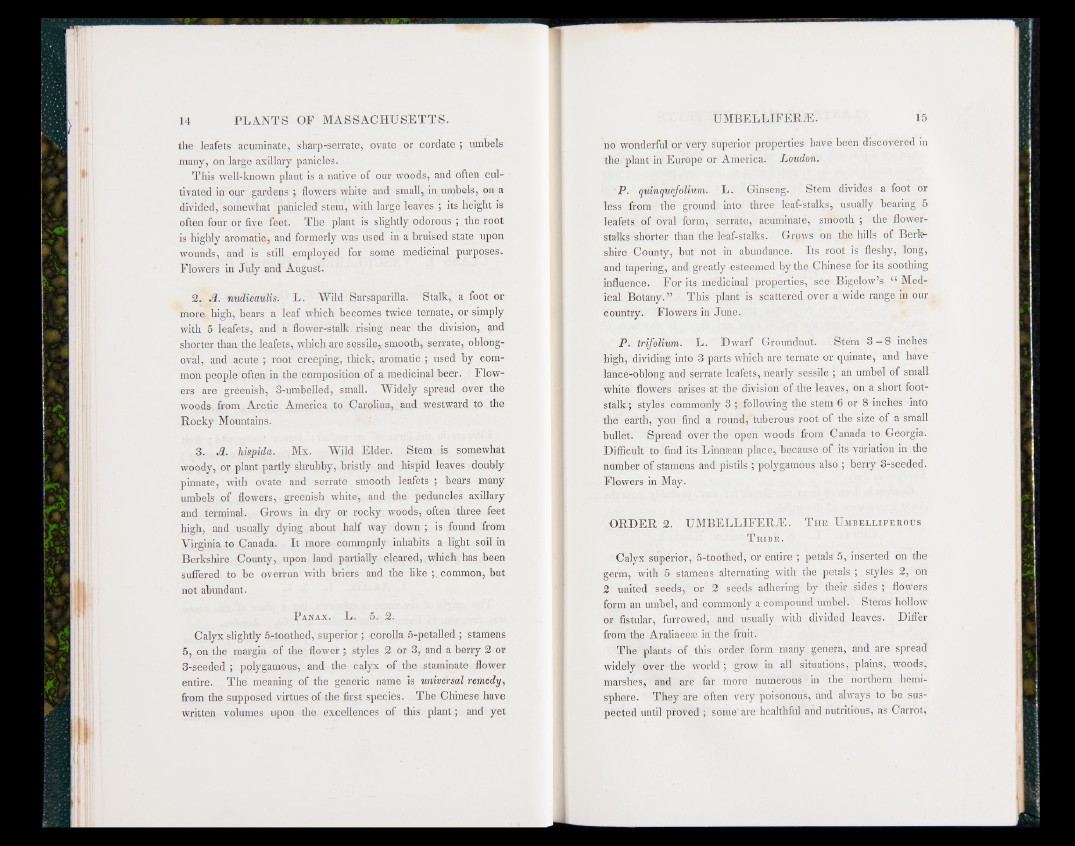
the leafets acuminate, sharp-serrate, ovate or cordate ; umbels
many, on large axillary panicles.
This well-known plant is a native of our woods, and often cultivated
in our gardens ; flowers white and small, in umbels, on a
divided, somewhat panicled stem, with large leaves ; its height is
often four or five feet. The plant is slightly odorous ; the root
is highly aromatic, and formerly was used in a bruised state upon
wounds, and is still employed for some medicinal purposes.
Flowers in July and August.
2. Jl. nudicaulis. L. Wild Sarsaparilla. Stalk, a foot or
more high, bears a leaf which becomes twice ternate, or simply
with 5 leafets, and a flower-stalk rising near the division, and
shorter than the leafets, which are sessile,- smooth, serrate, oblong-
oval, and acute ; root creeping, thick, aromatic ; used by common
people often in the composition of a medicinal beer. Flowers
are greenish, 3-umbelled, small. W idely spread over the
woods from Arctic America to Carolina, and westward to the
Rocky Mountains.
3. Jl. hispida. Mx. Wild Elder. Stem is somewhat
woody, or plant partly- shrubby, bristly and hispid leaves doubly
pinnate, with ovate and serrate smooth leafets ; bears many
umbels of flowers, greenish white, and the peduncles axillary
and terminal. Grows in dry or rocky woods, often .three feet
high, and usually dying about half way down ; is found from
Virginia to Canada. It more commpnly inhabits a light soil in
Berkshire County, upon land partially cleared, which has been
suffered to he overrun with briers and the like common, but
not abundant.
P anax. L. 5. 2.
Calyx slightly 5-toothed, superior ; corolla 5-petalled ; stamens
5, on the margin of the flower ; styles 2 or 3, and a berry 2 or
3-seeded ; polygamous, and the calyx of the staminate flower
entire. The meaning of the generic name is universal remedy,
from the supposed virtues of the first species. The Chinese have
written volumes upon the excellences of this plant ; and yet
no wonderful or very superior properties have been discovered in
the plant in Europe or America. Loudon.
P. quinquefolium. L. Ginseng. Stem divides a foot or
less from the ground into three leaf-stalks, usually bearing 5
leafets of oval form, serrate, acuminate, smooth ; the flower-
stalks shorter than the leaf-stalks. Grows on the hills of Berkshire
County, but not in abundance. Its root is fleshy, long,
and tapering, and greatly esteemed by the Chinese for its soothing
influence. For its medicinal properties, see- Bigelow’s “ Medical
Botany.” This plant is scattered over a wide range in our
country. Flowers in June.
P. trifolium. L. Dwarf Groundnut. Stem 3 - 8 inches
high, dividing into 3 parts which are ternate or quinate, and have
lance-oblong and serrate leafets, nearly sessile ; an umbel of small
white flowers arises at the division of the leaves, on a short footstalk,;
styles commonly 3 ; following the stem 6 or 8 inches into
the earth, you find a round, tuberous root of the size of a small
bullet. Spread over the open woods from Canada to Georgia.
Difficult to find its Linnaean place, because of its variation in the
number of stamens and pistils ; polygamous also ; berry 3-seeded.
Flowers in May.
ORDER 2. UMBELLIFERiE. T he U mbelliferous
T r ib e .
Calyx superior, 5-toothed, or entire ; petals 5, inserted on the
germ, with 5 stamens alternating with the petals ; styles 2, on
2 united seeds, or 2 seeds adhering by their sides ; flowers
form an umbel, and commonly a compound umbel. Stems hollow
or fistular, furrowed, and usually with divided leaves. Differ
from the Araliacese in the fruit.
The plants of this order form many genera, and are spread
widely over the world; grow in all situations, plains, woods,
marshes, and are far more numerous in the northern hemisphere.
They are often very poisonous, and always to be suspected
until proved ; some'are healthful and nutritious, as Carrot,